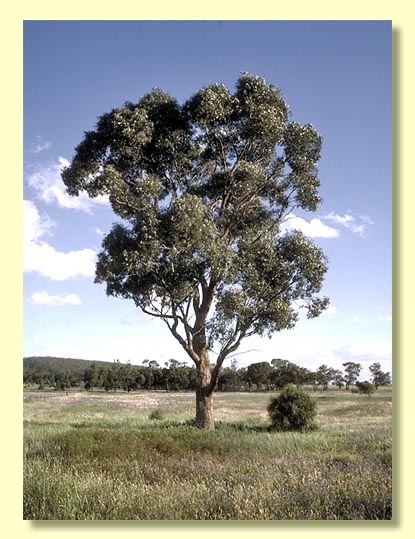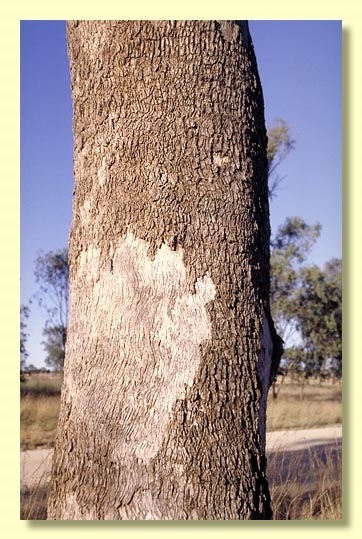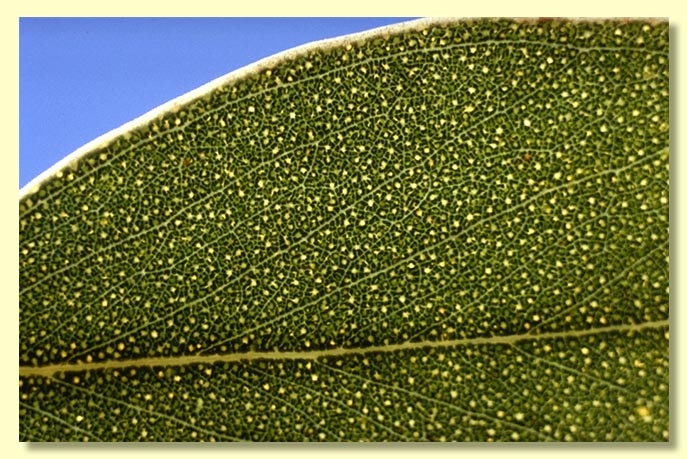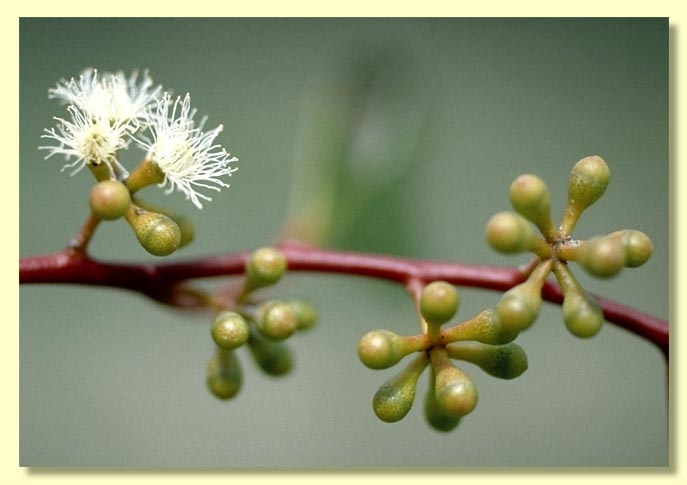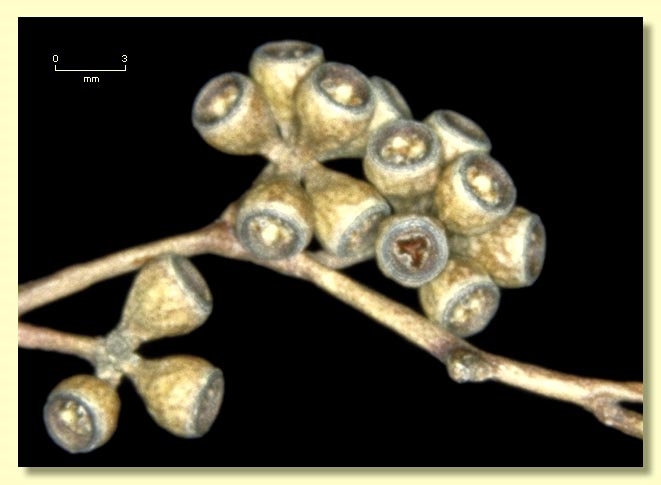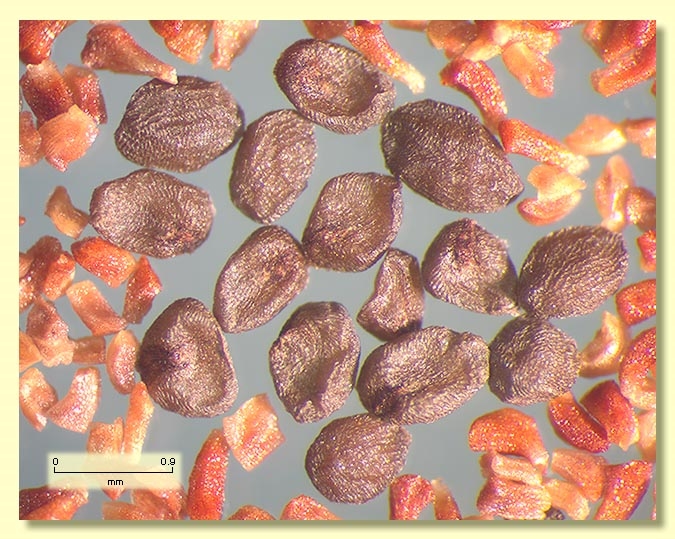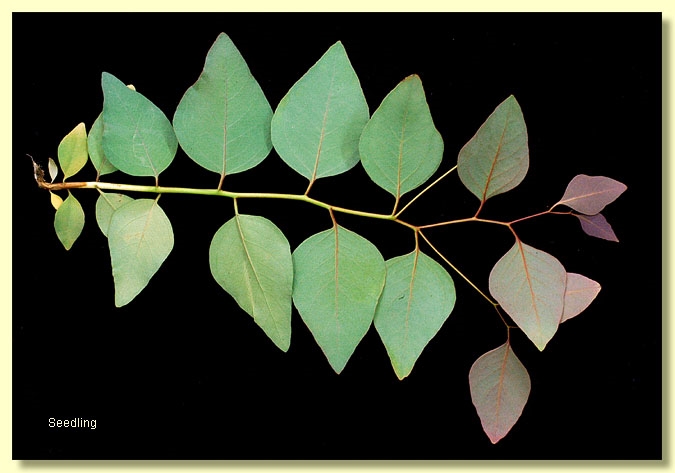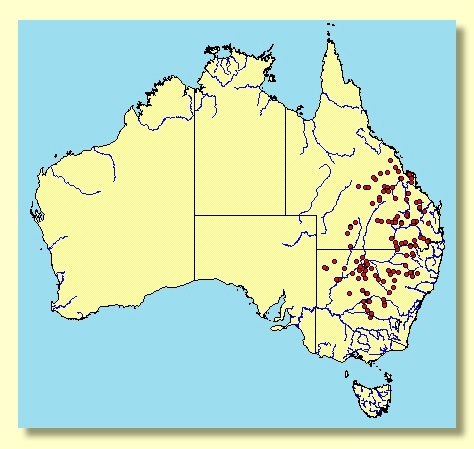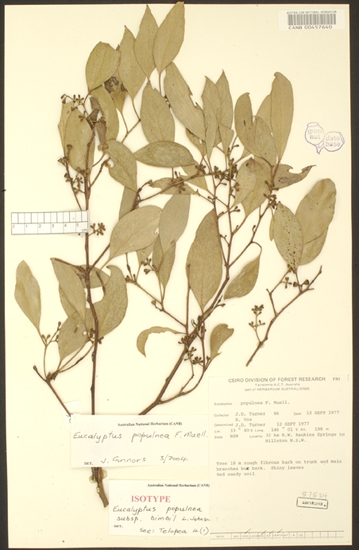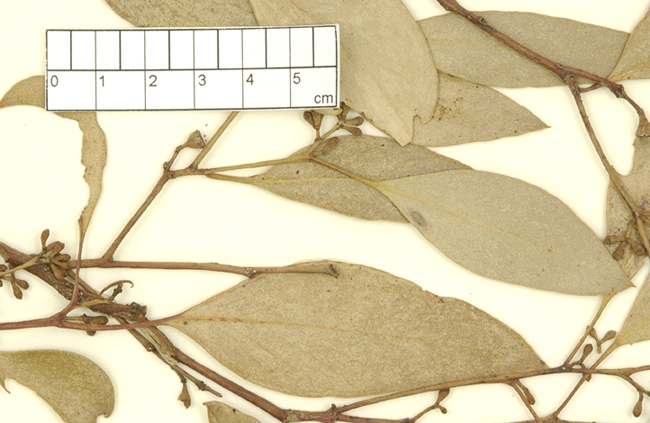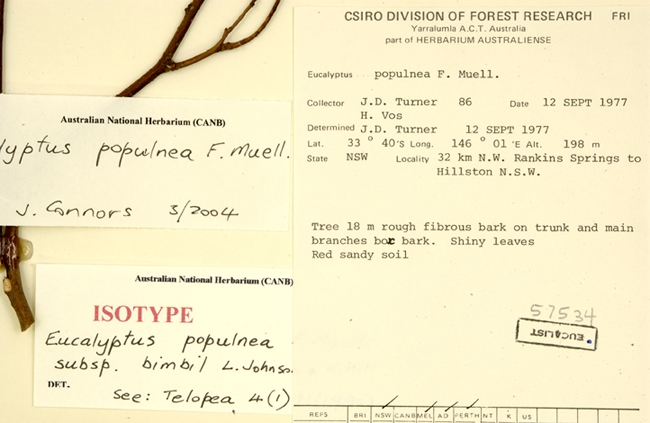Euclid - Online edition
Eucalyptus populnea
Eucalyptus | Symphyomyrtus | Adnataria | Apicales | Buxeales | Amissae
Eucalyptus populifolia Hook. in T.L.Mitchell, J. Exped. Trop. Australia 204 (1848), non Desf. (1829). T: near Mt Owen, Maranoa R., Qld, T.L.Mitchell s.n.
Eucalyptus populifolia Hook., Icon. Pl. t. 879 (1851), non Desf. (1829) nec Hook. (1848). T: Wide Bay district, [presumably collected inland from Wide Bay, as this taxon does not occur near the coast in that area], Qld, J.T.Bidwill 76; holo: K.
Eucalyptus populnea F.Muell. subsp. bimbil L.A.S.Johnson & K.D.Hill, Telopea 4: 71 (1990). T: NSW, South Western Plains, 32km NW of Rankin Springs towards Hillston, 12 Sep. 1977, J.D.Turner 86 & H.Vos; holo: NSW; iso: AD, CANB, MEL, PERTH.
Bark rough to small branches, box-type or tessellated, grey to grey-brown.
Juvenile growth (coppice or field seedlings to 50 cm): leaves always petiolate, opposite for a few nodes then alternate, ovate or orbicular, 6–11.5 cm long, 3.5–9.5 cm wide, bases rounded or tapering to petiole, first few pairs dull green to grey-green, soon notably glossy, green.
Crown often with many intermediate leaves. Crown leaves alternate, petiole 1–3.2 cm long; blade orbicular to ovate or elliptical, rarely narrowly so, 4–11 cm long, (1.3)1.8–5 cm wide, apex broadly pointed to rounded or sometimes indented (emarginate), base tapering to petiole, concolorous, glossy, green, side-veins acute, densely to very densely reticulate, intramarginal vein parallel to and remote from margin, oil glands mostly intersectional.
Inflorescence terminal compound, or with some compound in subterminal axils also, peduncles 0.4–1.1 cm long, buds 7 to >15 per umbel, pedicels 0.1–0.4 cm long. Mature buds oblong to obovoid to globular, 0.3–0.5 cm long, 0.2–0.3 cm wide, green or yellow, scar present, operculum conical to rounded, stamens irregularly flexed, anthers adnate, cuboid to globoid, dehiscing by broad lateral pores, style long or short, stigma blunt or pin-head shaped, locules usually 4, the placentae each with 4 vertical ovule rows. Flowers white.
Fruit on pedicels (0)0.1–0.3 cm long, obconical to hemispherical or ± cupular, 0.2–0.4(0.5) cm long, 0.2–0.4 cm wide, disc descending, valves usually 4, near rim level or enclosed.
Seeds brown or grey, 1–1.5 mm long, flattened-ovoid, often pointed at one end, dorsal surface shallowly pitted, hilum ventral.
Cultivated seedlings (measured at ca node 10): cotyledons reniform to ± oblong; stems rounded to square in cross-section, smooth or slightly warty; leaves always petiolate, opposite for 4–8 pairs then alternate, ovate to elliptic, 4–10.1 cm long, 1.4–5.5 cm wide, base tapering or rounded, margin entire, apex pointed or rounded, dull, slightly discolorous, green.
Flowering has been recorded in May, August, September, October, November and December.
A small to medium-sized woodland box tree widespread in the western plains of New South Wales extending as far west as Packsaddle Creek north of Broken Hill, and over large areas of central, south-eastern Queensland, on red loamy soils that are slightly better watered than the surrounding country. It is easily recognised by the rough box-type bark over the whole trunk and branches and particularly by the broadly elliptical to orbicular, glossy green leaves.
Two subspecies have been described, viz. the typical form which has orbicular leaves and occupies the north-eastern part of the distribution, and subsp. bimbil, which has narrower leaves and occurs in the New South Wales part of the distribution. However, a thorough inspection of herbarium specimens shows that the distribution of subsp. bimbil is sporadic throughout the entire distribution of the species and also that many specimens are intermediate in leaf characters between the two subspecies. Therefore, we do not recognize subsp. bimbil as a distinct subspecies.
Eucalyptus populnea belongs to Eucalyptus subgenus Symphyomyrtus section Adnataria (the boxes) because the buds have two opercula, ovules are in four rows, seeds are flattened-ovoid, cotyledons are more or less reniform and anthers are rigid on the staminal filaments. Within section Adnataria, E. populnea is part of a subgroup, series Buxeales, further distinguished by being partially rough-barked, having terminal inflorescences and buds that lose the outer operculum early. E. populnea and close relatives E. behriana in south-eastern Australia and E. sparsa in Central Australia have stamens irregularly arranged and all fertile, and very glossy adult leaves. Two other related species occur in north-eastern Australia, E. brownii and E. cambageana, neither overlapping in distribution with E. sparsa and E. behriana. E. brownii differs by normally having narrow lanceolate adult leaves (normally orbicular to broadly ovate in E. populnea). However, in areas of central Queensland where the northern limit of E. populnea meets the southern limit of E. brownii, intermediates in leaf morphology are common. E. cambageana differs by have conspicuously smooth-barked upper trunks and branches.

